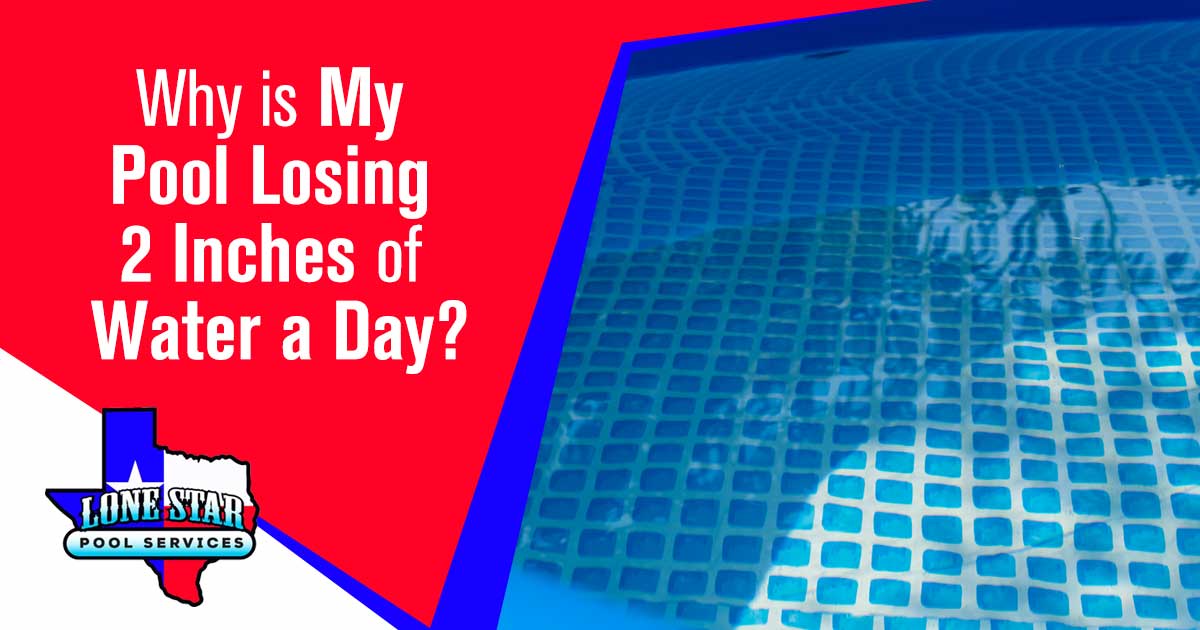How Much Water Loss in My Swimming Pool Is Normal?
Water loss in a swimming pool can vary greatly depending on weather and climate conditions, and your pool will experience more water loss due to evaporation during a drought than it will when it’s wet and rainy. Typically, however, swimming pools lose about ¼” of water on average per day, but this is variable depending on factors like the pool’s total surface area, temperature, humidity, and wind.
Suppose your swimming pool is losing more than ½” of water per day. In that case, this is an indication that you have a leak in your swimming pool’s structure or pool pump system. If your pool is losing more than ½” of water daily, it’s best to get a thorough leak detection inspection from your local pool service company.
Are There Normal Reasons My Swimming Pool Might Be Losing Water?
Most swimming pools lose approximately ¼” of water daily, about 2” per week. Warmer and more humid climates might experience a slightly higher amount of water loss, but that water loss is sometimes replenished with rainwater.
Typical reasons your swimming pool might be losing water include:
1. Splash Out
Splash-out happens naturally when swimmers enter or leave the swimming pool. Water features like waterfalls and spillways can also cause splash out. While water loss from splashing out would be barely noticeable, it can add up throughout the day with several swimmers using the pool.
2. Relative Humidity
The combination of low humidity, high temperatures, and sun exposure can lead to excessive evaporation of your swimming pool’s water.
3. Backwash
The backwash feature of some filtration systems can increase the rate at which a swimming pool needs to be filled. It’s also possible that the multiport valve could be leaking water out of the backwash line, so it’s a good idea to check this.
4. Evaporation
Many different things can cause water to evaporate in varying amounts, but the general rule is that more than ½” of water loss in a day needs to be investigated. To keep evaporation at a minimum, there should be a maximum difference of 2 to 4 degrees between the air temperature and water temperature.
5. Wind
Depending on where you live and your landscaping, wind can be a big problem for swimming pools without automatic covers. Windy conditions will change the surface area of your pool’s water and increase heat loss and evaporation.
Common Areas Where A Swimming Pool Might Be Leaking
Any part of your swimming pool that holds water could be responsible for a leak, but there are some common areas to check:
- Skimmer
- Main Drain
- Pool Lights and Jets
- Return Piping
- Pool Structure
Are There Clues That Tell Where My Pool Might Be Leaking?
If you think your swimming pool might be leaking, some clues can help determine where the leak is coming from.
- Does your swimming pool lose water when the pumps are turned on or off? This can indicate a potential structural problem rather than a plumbing problem.
- Where does your swimming pool’s water stabilize? If it stabilizes right by a light niche or skimmer housing, those are often the source of the leak.
- Are there any wet spots at the equipment pad or in the yard? A quick visual check of these areas can verify if your pool equipment is causing a leak. Discovering any swampy areas in your yard can indicate a leak underground.
- If you suspect your pool equipment is responsible for the leak, narrow it down to which pump by only using one at a time. This helps determine which part of your swimming pool’s plumbing system is causing the leak.
- If you have a spa, does it share the same equipment as your pool? If so, running the spa for 30 minutes and marking the water level before and after will help eliminate your spa as a possible culprit.
What Should I Do If I Think I Have a Pool Leak?
If you think your swimming pool is losing water because of a pool leak, you can do a do-it-yourself bucket test to check for a leak before hiring a pool technician for leak detection services.
DIY Bucket Test
The DIY bucket test is a great tool for determining whether your water loss is from evaporation or a leak. If it rains while you are conducting the test, you’ll have to start over.
- Fill your pool to its normal level, turn off your autofill system if you have one, turn off your pool pump, and do not add any more water.
- Mark the pool water level on the skimmer.
- Take a bucket fill 3/4 of the way and mark the top water line inside the bucket.
- Place the bucket on the first or second step in your pool. About 6 inches of the bucket should be below water. Mark the water level outside the bucket.
- Wait 24 hours. You must wait a total of 24 hours.
- Repeat the test while the pump is running continuously.
If the water levels in the bucket and pool go down the same amount, water loss is most likely due to evaporation. You likely have a leak if the pool’s water level drops more than the bucket’s. If the water level goes down with your pool system turned off, you may have a leak or structural leak in your suction side plumbing. If your pool only loses water when the pool system is running, you most likely leak your pool pump system’s pressure side plumbing.
Contact Lone Star Pool Services for Leak Detection and Repair
If your inground pool is experiencing water loss or your DIY bucket test results show you a leak, it’s time to call a professional pool leak detection service. These experts use a combination of advanced equipment and techniques to pinpoint the source of the leak accurately. Call Lone Star Pool Services at (832) 928-3017 or use our online contact form to schedule your leak detection service.

